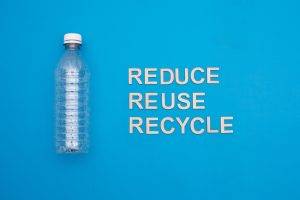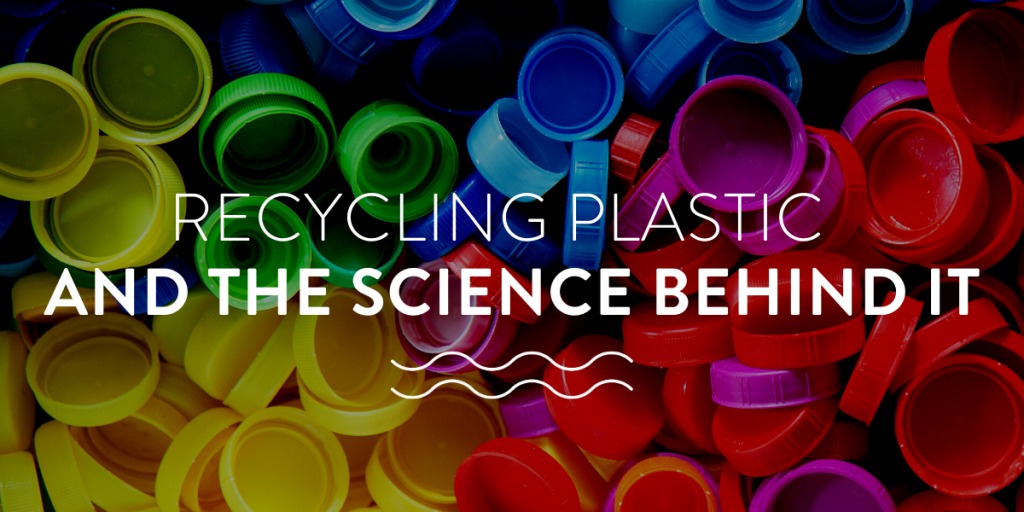Are we the only ones fascinated with plastic and recycling? Ok, maybe! So Ocean Mimic is a charity and movement obsessed with getting rid of plastic, finding ways to reduce it, recycling it into swimwear and remove it from the oceans, but what is it actually? What makes it this incredibly cheap and durable waterproof wonder material? How is it recycled and what can you do as an individual?
What is plastic?
The word plastic comes from Greek πλαστικός (plastikos) – able to be shaped or moulded. This property of plastic is what makes it so special. Believe it or not plastics were first discovered around 1600 BC in Mesoamerica and used by Mayans and Aztecs! The first plastics were natural latex found in nature from the saps in rubber trees. Aztecs were creating waterproof containers using latex sap.
Plastics are polymers – chains of many monomers. Think of polymers as being a train and each carriage is a monomer. The monomers are based on hydrogen and carbon and some other elements. So they exist in nature. There is sap in rubber trees, amber which is a fossilized tree resin, sticky tape which came from cellulose found in plants and in Nazi Germany they tried making rubber from latex found in dandelion’s (but failed)!
However, most natural plastics need treating to be used in a practical way and these days they mostly come from fossil fuels.
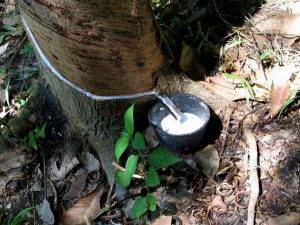
Types of plastic
So as you can imagine the waterproofing sap the Aztecs used is a very different plastic from the plastic bottles we use today. There are many ways we can categorise plastics. One way is that some plastics can be melted down like plastic bags (thermoplastics) and some once moulded don’t like your non-stick coating in your pan (thermosets).
There are hundreds of types of plastics some with very specialised uses. However, most of the plastics we use in everyday life are thermoplastics. They break down when we heat them up, which is good news for recycling because that’s what most recycling facilities do – they heat them up in order to do something new with them.
Another important way to categorize plastics is by their Plastic Identification Code (PIC). This was created to help recycling facilities identify plastics during sorting and processing. In some countries and regions a PIC is mandatory when you manufacture something in others it is optional. A plastic having a PIC doesn’t mean that it is recyclable and it varies from region to region.
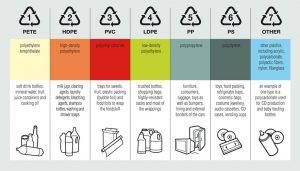
The easiest plastics to recycle are PET, HDPE and LDPE.
What we can do as consumers is choose our plastic wisely. If we need to buy plastic, we can try to avoid certain plastics and we can separate, clean and sort our waste so that it has the biggest chance possible to have another life. Almost in the same way as we can prepare a baby turtle to have the biggest chance possible to survive it’s journey into the ocean! More on this later.
Does my bottle get recycled into a new bottle?
Every plastic will undergo a slightly different process so let’s look at a classic bottle made of PET. PET is the most common type of polyester. When we talk about clothing we say polyester and when we talk about packaging we say PET, but it’s the same thing. Around the world 60% of PET is used in fibres and 30% is for bottles.
Once it is recycled it is commonly used for carpet fibres, strapping and non-food packaging. It is difficult to recycle plastics into food grade plastic because plastics can absorb harmful and toxic chemicals if they come into contact with them. Currently the FDA (Food and Drug Administration) and other boards worldwide commonly approve processes individually case by case. So that bottle you throw in recycling is most likely not going to be reborn into another bottle.
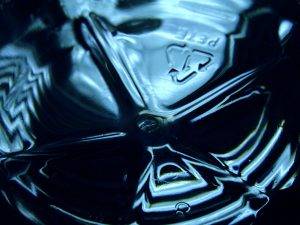
What is the recycling process for a plastic bottle?
1)Waste Management
First of all waste is collected and taken to a sorting facility. There the bottle label and cap are removed leaving behind the pure PET material. Then the bottles are often sorted by colour and crushed and baled and sold to a third party. Colourless plastics are more useful and therefore more valuable than the coloured plastics.
One shocking fact is that at some facilities if the waste is contaminated with food waste or dirty it is thrown to landfill because it’s too resource intensive to clean it.
2)Flake Production
These bales of PET eventually arrive at a processing facility which creates ‘flakes’. They clean and shred the plastic into flakes or pellets. The new recycled PET is labelled as rPET.
3)Flake Processing
Finally, these flakes are used to make new products.
The interesting step here is flake production. There are two types – chemical recycling and mechanical recycling.
Chemical recycling breaks the PET down into its raw materials so what you get is as pure and refined as a virgin plastic and can be used for food grade materials. This sounds great, but it’s hard. The process only becomes cost efficient with around 50,000 tonnes of plastic coming in a year and the price of recycled plastic is constantly fluctuating. These plants are rare and currently unstable. There is a lot of money invested into making this work.
Mechanical recycling is what’s happening most of the time. The problem is that the rPET you end up with is not the same quality as the virgin material. For manufacturers to use this material they often have to mix virgin plastic with it to improve the integrity of the material. This is why you will have heard that plastic can only be recycled 2-3 times before it is unusable.
So there you have it! Bear in mind that PET is just one example and it’s the easiest plastic to recycle. For other plastics this process gets less cost effective and more even complicated.
So, what can you do?
Now that you know all this geeky information what can you do?
First and foremost, cut down on plastic waste however you can. Even if that plastic bottle is made of see through 100% recycled PET it is better to fill up a reusable bottle. However, don’t throw away all your plastic bags and toothbrushes to buy all the trendy sustainable alternatives. Use them until they break! Then get your bamboo toothbrush and tote bags.
If you need to use something plastic then choose quality products, recycled materials or easily recyclable materials (one type of plastic, PET, colourless). Use it as long as you can. Repair it when it breaks and when you can’t use it any more prepare it for recycling as best you can so it has the best chance possible to be recycled. Make sure it’s clean and goes in the bin with other clean plastics.
Recycling isn’t the single answer to our plastic mess but it is an important part of the problem we need to solve. Please let us know what you think about the article!
